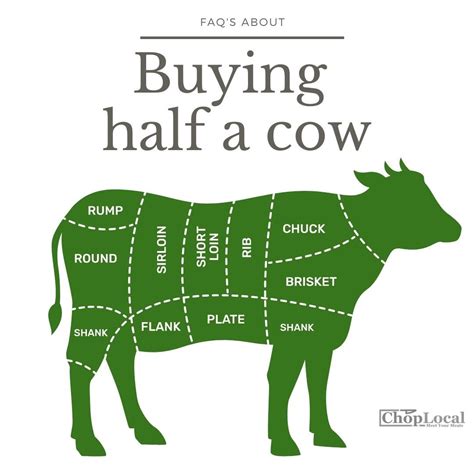Half a Cow: More Meat, Less Fuss
Buying half a cow might sound daunting, but for many families, it's the ultimate solution for delicious, affordable, and convenient meat. This approach offers significant advantages over weekly grocery store trips, providing a bounty of fresh meat while reducing food waste and potentially saving money. This comprehensive guide delves into the benefits, considerations, and practical steps involved in purchasing and managing half a cow.
Is Buying Half a Cow Right for Me?
This is the crucial first question. Consider these factors:
-
Storage Space: You'll need a large freezer (or multiple freezers) to store the substantial amount of meat. Think 10-15 cubic feet minimum, depending on the size of the cow and how much you choose to keep frozen versus initially processing for immediate use.
-
Budget: While the upfront cost is significant, the long-term cost per pound of meat is usually lower than buying pre-packaged cuts from the grocery store. Consider the total cost, including processing fees, and compare it to your current meat spending over a similar timeframe.
-
Lifestyle: Do you enjoy cooking and are you willing to commit to using the meat within a reasonable timeframe (ideally within a year)? Proper storage is essential to maintain quality.
-
Family Size: A half cow is ideal for larger families or those who frequently entertain, but even smaller families can make it work if they're willing to share or freeze portions.
What Does Buying Half a Cow Entail?
Buying half a cow involves several key steps:
-
Finding a Farmer or Rancher: This might involve searching online, visiting local farmers' markets, or asking for recommendations from friends and family. Look for farms that prioritize sustainable and humane practices.
-
Choosing Your Cuts: Many farmers offer a standard cut sheet, but you can often customize the cuts to your preferences. Consider your family's favorite meals and request more of those cuts.
-
Processing: The farmer will likely handle the butchering and processing, but you'll need to discuss your preferences for cuts, packaging, and freezing. This often incurs an additional processing fee.
-
Storage: As mentioned, ample freezer space is critical. Proper labeling and organization are vital to easily access and utilize your meat.
-
Understanding the Costs: Prices vary based on location, the type of cow, and processing fees. Get a detailed breakdown of all costs upfront.
How Much Meat Will I Get from Half a Cow?
The amount of meat you receive depends on the size of the cow, but you can generally expect between 250 and 400 pounds of meat. This includes a variety of cuts, such as:
- Steaks: Ribeye, sirloin, T-bone, New York strip, etc.
- Roasts: Chuck roast, brisket, rump roast, etc.
- Ground Beef: A significant quantity for burgers, chili, and other ground beef dishes.
- Other Cuts: Shanks, short ribs, stew meat, etc.
How Long Does Half a Cow Last in the Freezer?
Properly stored in a deep freezer (0°F or -18°C), meat from half a cow can last for 6-12 months, even up to two years, without significant quality loss. However, for optimal flavor and texture, it’s best to use it within a year.
What Are the Benefits of Buying Half a Cow?
-
Cost Savings: Often, the cost per pound is significantly less than buying retail cuts.
-
Quality Control: You'll know the source of your meat and how it was raised.
-
Reduced Food Waste: You're buying exactly what you need, minimizing waste compared to buying individual cuts.
-
Variety of Cuts: You'll have a wide selection of different cuts for diverse meals.
-
Sustainability: Supporting local farmers and ranchers contributes to sustainable agriculture.
What Are the Drawbacks of Buying Half a Cow?
-
Upfront Cost: The initial investment can be significant.
-
Storage Requirements: You need a large freezer.
-
Time Commitment: You need to plan your meals around using the meat over time.
-
Potential for Freezer Burn: Proper freezing and labeling are essential to prevent freezer burn.
-
Not Suitable for Everyone: Not all households have the storage or consumption needs to make this approach practical.
How Do I Choose a Good Farmer or Rancher?
-
Ask Questions: Inquire about their farming practices, animal welfare standards, and processing methods.
-
Visit the Farm: If possible, visit the farm to see the animals and their environment firsthand.
-
Check Reviews: Read online reviews or ask for recommendations from others who have purchased meat from them.
-
Look for Certifications: Check if the farm has any certifications related to sustainability or animal welfare.
In conclusion, buying half a cow is a significant commitment, but for the right family, it can be a rewarding experience that provides high-quality, affordable meat. Careful planning, adequate storage, and selecting a reputable farmer are key to a successful half-cow purchase.

